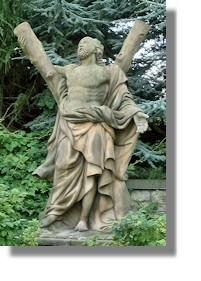

Gaelic and Celtic Customs
from the Hebrides and Beyond
Fada's Farsaing (Far and Wide) is a series of articles by Liam O Caiside in English but with Gaelic words and phrases interwoven in the text. The articles describe a wide range of Gaelic and Celtic customs. These pages were originally published in the "Scottish Radiance" e-magazine and have been reproduced here with the kind permission of the Scottish Radiance editor, Sharma Krauskopf.
St Andrew

Saint Andrew is the Patron Saint of Scotland, and St. Andrew's Day is celebrated by Scots around the world on the 30th November. The flag of Scotland is the Cross of St. Andrew, and this is widely displayed as a symbol of national identity.
Very little is really known about St. Andrew himself. He was thought to have been a fisherman in Galilee (now part of Israel), along with his elder brother Simon Peter (Saint Peter). Both became followers (apostles) of Jesus Christ, founder of the Christian religion.
St. Andrew is said to have been responsible for spreading the tenets of the Christian religion through Asia Minor and Greece. Tradition suggests that St. Andrew was put to death by the Romans in Patras, Southern Greece by being pinned to a cross (crucified). The diagonal shape of this cross is said to be the basis for the Cross of St. Andrew which appears on the Scottish Flag.
St. Andrews bones were entombed, and around 300 years later were moved by Emperor Constantine (the Great) to his new capital Constantinople (now Istanbul in Turkey). Legend suggests that a Greek Monk (although others describe him as an Irish assistant of St. Columba) called St. Rule (or St. Regulus) was warned in a dream that St. Andrews remains were to be moved and was directed by an angel to take those of the remains which he could to the "ends of the earth" for safe-keeping.
St. Rule dutifully followed these directions, removing a tooth, an arm bone, a kneecap and some fingers from St. Andrew's tomb and transporting these as far away as he could. Scotland was close to the extremities of the know world at that time and it was here that St. Rule was shipwrecked with his precious cargo.
St. Rule is said to have come ashore at a Pictish settlement on the East Coast of Scotland and this later became St. Andrews. Thus the association of St. Andrew with Scotland was said to have begun. St Rule's tower (see illustration on the right) was located in the grounds of the cathedral at St Andrews but predates it, having served as the church of the priory up to the early 12th century. The building was retained to allow worship to continue uninterrupted during the building of its much larger successor. Originally, the tower and adjoining choir were part of the church built in the 11th century to house the relics of St Andrew.
Perhaps more likely than the tale of St. Rule's journey is that Acca, the Bishop of Hexham, who was a well known collector of relics, brought the relics of St. Andrew to St. Andrews in 733. There certainly seems to have been a religious centre at St. Andrews at that time, either founded by St. Rule in the 6th century or by a Pictish King, Ungus, who reigned from 731 - 761.
Whichever tale is true, the relics were placed in a specially constructed chapel. This chapel was replaced by the Cathedral of St. Andrews in 1160, and St. Andrews became the religious capital of Scotland and a great centre for Medieval pilgrims who came to view the relics.
There are other legends of how St. Andrew and his remains became associated with Scotland, but there is little evidence for any of these, including the legend of St. Rule. The names still exist in Scotland today, including St. Rules Tower, which remains today amongst the ruins of St. Andrews Cathedral.
It is not known what happened to the relics of St. Andrew which were stored in St. Andrews Cathedral, although it is most likely that these were destroyed during the Scottish Reformation. The Protestant cause, propounded by Knox, Wishart and others, won out over Roman Catholicism during the Reformation and the "idolatry of catholicism", that is the Saints, relics, decoration of churches, were expunged during the process of converting the Roman Catholic churches of Scotland to the harsh simplicity of Knox's brand of Calvanism.
The place where these relics were kept within the Cathedral at St. Andrews (see illustration on the right) is now marked by a plaque, amongst the ruins, for visitors to see. The larger part of St. Andrew's remains were stolen from Constantinople in 1210 and are now to be found in Amalfi in Southern Italy. In 1879 the Archbishop of Amalfi sent a small piece of the Saint's shoulder blade to the re-established Roman Catholic community in Scotland.
During his visit in 1969, Pope Paul VI gave further relics of St. Andrew to Scotland with the words "Saint Peter gives you his brother" and these are now displayed in a reliquary in St. Mary's Roman Catholic Cathedral in Edinburgh.
Return to Fada's Farsaig Index
Where else would you like to go in Scotland?

